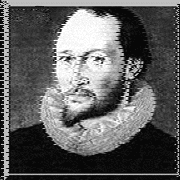 Little
is known of Thomas
Harriot
in his early years, except that his
father was a commoner in the county of Oxford. He entered the
University of Oxford when he was 17 years old. He completed his
degree at St. Mary's Hall in 1580, then moved to London, where he was
employed by Sir Walter Raleigh. In 1585, he joined Raleigh on an
expedition to Virginia, in a position of staff scientist. Harriot was
well-versed in navigational theories and worked as a cartographer. In
1586, he returned to England and wrote what would be his only
published work, entitled "A Briefe and True Report of the New Found
Land of Virginia."
Little
is known of Thomas
Harriot
in his early years, except that his
father was a commoner in the county of Oxford. He entered the
University of Oxford when he was 17 years old. He completed his
degree at St. Mary's Hall in 1580, then moved to London, where he was
employed by Sir Walter Raleigh. In 1585, he joined Raleigh on an
expedition to Virginia, in a position of staff scientist. Harriot was
well-versed in navigational theories and worked as a cartographer. In
1586, he returned to England and wrote what would be his only
published work, entitled "A Briefe and True Report of the New Found
Land of Virginia."
Harriot lived in Ireland for a few years, in a former abbey granted by Raleigh, before returned to London. In 1598, he joined the service of the ninth Earl of Northumberland, William Percy, who gave him living quarters west of London, in Syon House, and a pension. In 1605, he was arrested along with Northumberland, due to the Gunpowder Plot. Although Northumberland stayed in the Tower of London until 1622, Harriot was quickly released and returned to Syon House. There, he studied optics, discovered Snell's law of refraction (before Snell) and corresponded with Johannes Kepler.
Harriot's broad range of study included significant contributions to algebra and astronomy. Between 1609 and 1613, he observed the heavens through telescopes, regarding what he saw. This included the first recorded telescopic drawing of the moon in early August 1609, several months before Galileo's moon studies. Harriot also made the first recorded observation of sunspots in December of 1610. Although he did not publish his findings, he shared them with correspondents. After his death of cancer in 1613, Harriot left several scientific manuscripts, which have slowly percolated into the mainstream of historical research over the past three centuries.
Designed by: Karen Niemeier
Shirley, John W. (1983). Thomas Harriot: A Biography. Oxford: Clarendon Press.
Thomas Harriot website [Online]. Available at http://www.luminarium.org/renlit/hariot.htm